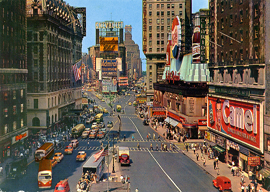
May 26, 2011

Times Square circa 1950
Edward Hopper painted his most recognizable work, Nighthawks, in 1941. It depicts a diner radiating a golden, melancholy light, a typical dead-of-night city scene. Hopper is my favorite painter because Nighthawks reminds me so much of a vanished New York: his shop’s cornices, the bricks and fire escapes looming in the background, his use of light—all of it now vanished to make space for luxury condos and expensive office towers. Hopper’s diner in Nighthawks never existed except in his imagination, but there were hundreds like them which very much existed, just as inexpensive candy stores, tobacco shops selling five-cent cigars, and bakeries used to line most streets below Park Avenue and in the Village.
Still, in summertime the place reeks of sex and promise. From my house I see the peaks and ridgelines of buildings along Fifth, Madison, and Park Avenues, not totally changed since the 50s, when I used to contemplate them from twenty blocks south. Ornate and chunky “cube” apartment buildings, spare, neoclassical ones, and the odd modernist design showed off American dynamism at its best. We’d stare for hours at girls sunbathing in their swimsuits on brownstones’ rooftops. Across the park, on Central Park West, there was a fairy-tale confection of towers, wrought-iron grills, and mock ch”teaux replete with peaked gables. Great pre-war buildings such as the Beresford and the Dakota are still around, thank God, but others have been replaced by Trump and Frank Gehry horrors, with perimeters of glass expressing vertical living at its worst. What the rich of yesterday would have thought of today’s flimsy castles in the sky is another matter. Residents in grand buildings of the past could choose to take their meals in vast, elegant dining rooms like passengers on grand liners. Today I’d hate to sit down and break bread with the nouveaux riches slobs I come across daily in chic restaurants.
Speaking of slobs, Elaine’s, the legendary dive where writers and artists used to meet with cops and firemen, closed this week. After Elaine Kauffman died six months ago, the place filled up with slobs who thought being loud and obnoxious made one an artist or a writer. Elaine used to throw these types out. The grotesque woman to whom she bequeathed the place did not know the difference. I’m glad the place closed. Too many fond memories of drunken all-nighters. That was the heyday of Clay Felker, Tom Wolfe, Norman Mailer, George Plimpton—even the poor little Greek boy. I used to hold editorial meetings for Taki’s Top Drawer there every Sunday night. Like everywhere, New York has changed. People now speak of the city the way Londoners try to hide London’s brittleness. New York used to be arrogant and self-assured. German, Jewish, and Scotch-Irish people made sure of it. New York led the arts from the end of the war until the end of the century. Creative types thronged to the city to produce their art. No longer. Now it’s only money that counts.